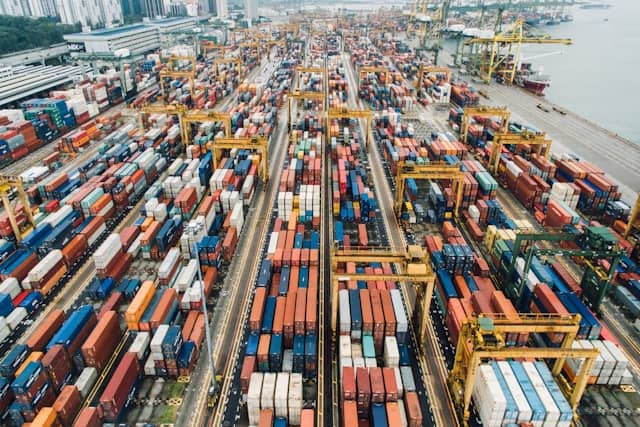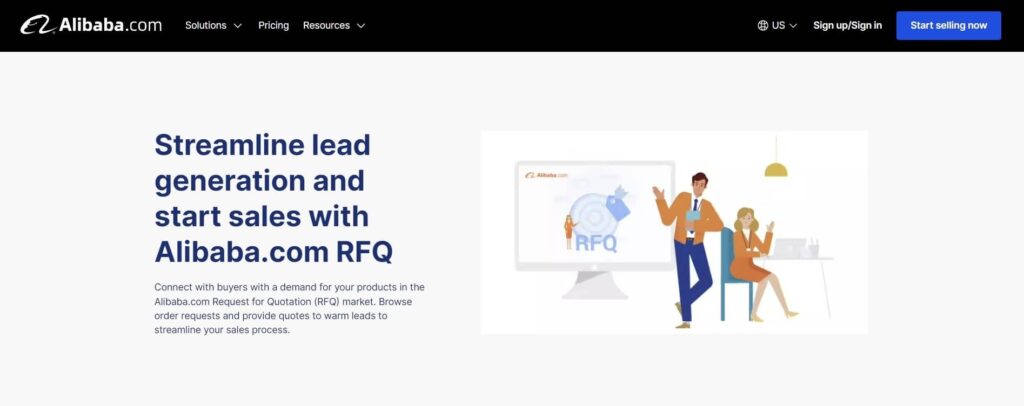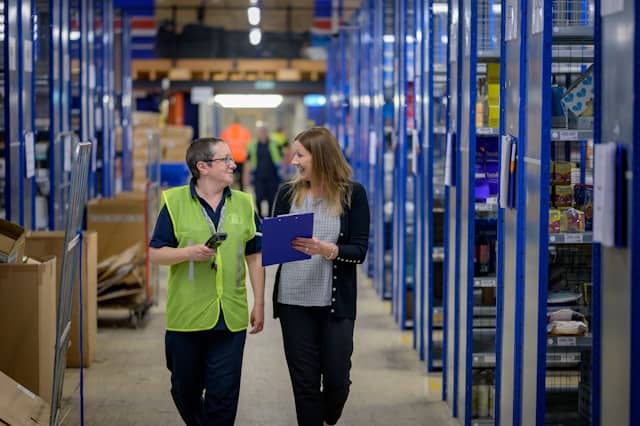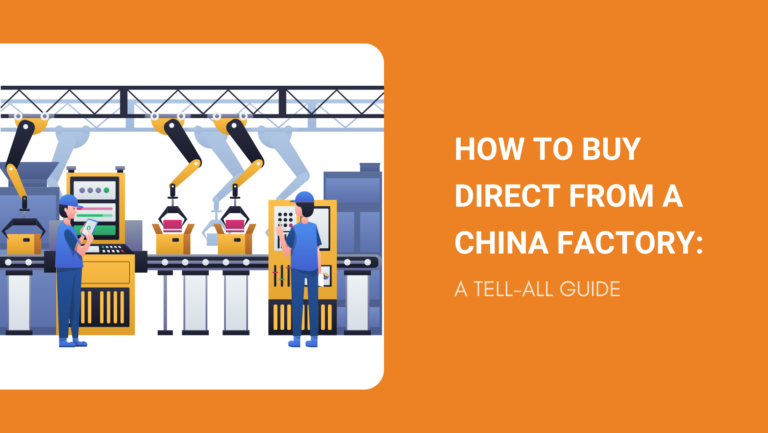Buying direct from China factory has become increasingly popular due to its cost-saving advantages.
By eliminating the middle-man, you can significantly increase your profit margins and customize products directly with manufacturers.
This allows for greater control over product quality and design, which is essential in today’s competitive market.
If you want to streamline your supply chain and improve profitability, understanding the process of buying directly from Chinese factories is crucial.
From identifying reliable suppliers to negotiating terms, this guide aims to provide all the necessary steps to ensure a seamless transaction.
Understanding the Supplier Types in China
When purchasing directly from factories in China, it’s crucial to understand the different types of suppliers. Each type offers unique benefits and potential drawbacks, making it essential to choose the right one for your specific needs.
Manufacturers vs. Trading Companies
Manufacturers are the producers of goods. They own factories and have direct control over the production process. This usually means lower prices since there’s no middleman.
However, manufacturers may have higher minimum order quantities (MOQs) and might specialize in limited product categories.
Trading companies, on the other hand, act as intermediaries between manufacturers and buyers. They offer a wider range of products since they source from multiple factories.
While this is convenient, trading companies often mark up prices to cover their operational costs.
Wholesalers and Distributors
Wholesalers purchase goods in large quantities from manufacturers and sell them to retailers or businesses. They usually offer lower prices than retailers but higher than manufacturers due to their markups.
Wholesalers also typically have lower MOQs than manufacturers, making them suitable for smaller businesses.
Distributors act similarly but often have exclusive rights to sell certain products within specific regions. They maintain larger inventories and can provide quicker deliveries.
Agents and Middlemen

Agents and middlemen, such as sourcing agents, bridge the gap between buyers and suppliers. They help identify reputable manufacturers and negotiate terms on your behalf.
This service adds convenience, especially if you’re unfamiliar with the Chinese market.
However, agents usually charge a commission or fee for their services, slightly increasing your costs. Despite this, the ease of communication and assurance of quality can outweigh these additional costs.
For personalized services, you might consider agents like NicheSources, which specialize in diverse sourcing needs.
Pros and Cons of Buying Direct from China Factory
Pros of Direct Buying from China Factory
Purchasing directly from a China factory provides multiple benefits. You can take advantage of cost savings, customize products to your requirements, and maintain direct communication with suppliers for better quality control.
Lower Costs
Eliminating intermediaries leads to significant cost savings. For instance, buying clothes directly from China factories can reduce expenses by up to 50%. This is because there are no middlemen adding their markups.
Factories in China often benefit from lower labor and manufacturing costs. You can increase profit margins by sourcing products cheaply.
For example, electronics or home goods purchased at factory prices offer better margins than buying from local distributors.
Customization and Quality Control
One major advantage of buying directly is the ability to customize products according to your specific requirements. Factories can adjust materials, colors, and designs to match your brand.
For example, customized apparel or gadgets enhance your product lineup and meet unique consumer needs.
Direct communication with factories enhances quality control. You can set your standards and specifications, ensuring the final product matches your expectations. Regular inspections and audits help maintain high-quality standards.
Direct Communication
Direct communication with manufacturers ensures order accuracy and builds strong relationships. You can clearly express your goals and expectations, minimizing misunderstandings.

Various tools and platforms facilitate this direct contact. For instance, WeChat, Alibaba TradeManager, and email are commonly used for instant communication with Chinese suppliers.
Engaging directly with suppliers also helps negotiate better terms and understand your manufacturing partners’ capabilities and constraints.
Direct relationships often lead to incremental benefits like priority treatment and better pricing. These interactions are essential for maintaining a seamless and efficient supply chain.
Cons of Direct Buying from China Factory
Buying directly from a factory in China can save costs but comes with certain challenges. Common issues include language and cultural barriers, high minimum order quantities, and logistic complications.
Language and Cultural Barriers
Language differences are a significant challenge when buying directly from China. Miscommunications can lead to errors in orders or misunderstandings about product specifications.
Many manufacturers speak limited English, making clear communication difficult.
Cultural differences further complicate business dealings. For instance, Chinese business etiquette prioritizes formal relationships and social hierarchies. Misunderstanding these norms can strain business relations.
To overcome these barriers, consider hiring bilingual staff or professional translators. Learning basic Chinese business etiquette can also help foster better relationships.
Minimum Order Quantities (MOQ)
Factories in China often require high Minimum Order Quantities (MOQs). These requirements exist because large-scale production lowers costs. Meeting these MOQs can be financially challenging for a small business.
For example, a factory may set an MOQ of 1,000 units for a product, which might be more than you need or can afford. This can tie up significant capital and risk unsold inventory.
You can negotiate lower MOQs by building a relationship with the supplier or offering a higher price per unit.
Logistic Challenges
International shipping from China involves navigating complex logistics. Shipping costs, customs regulations, and delivery times can be unpredictable and expensive. Managing these logistics requires careful planning and reliable partners.

Delays at customs or issues with shipping companies can disrupt your supply chain. To avoid surprises, calculate potential shipping costs using tools like shipping calculators.
Arranging efficient logistics includes selecting reputable freight forwarders and understanding import regulations. Reading logistics guides can equip you with the knowledge to handle these challenges effectively.
How to Buy Direct from China Factory: A Step-by-Step Guide
1. Research and Identify Potential Suppliers
Finding reliable suppliers is key to sourcing products directly from China. Online directories are a great starting point.
Alibaba is a popular platform that allows you to connect with thousands of manufacturers. You can also check Global Sources and Made-in-China. These platforms let you filter suppliers by certifications, such as ISO9001, ensuring quality management standards.
Tips for Evaluating Online Suppliers
- Review company profiles and capabilities.
- Check certifications and quality standards.
- Read customer reviews and ratings.
Trade Shows
Every year, Chinese manufacturers take part in trade fairs where they showcase their products to an international audience.
Some, like the China International Furniture Fair, are industry-specific while others like the Canton Fair host manufacturers across different sectors.
As you do your research, take note of the dates and locations of the trade fairs you would like to attend and plan accordingly. Keep in mind that the dates may change from one year to the next.
Industry Referrals
Networking with industry professionals can provide valuable recommendations. Referrals often come with insights about the supplier’s reliability and product quality.
Questions to Ask Potential Suppliers
When engaging with potential suppliers:
- How long have they been in business?
- What types of products do they specialize in?
- Can they provide references from previous clients?
Bonus Tips
- Use a mix of online research, trade shows, and referrals for comprehensive supplier vetting.
- Start with a small order to test the supplier’s reliability and product quality.
2. Verify Supplier Credentials

Verifying supplier credentials is crucial when buying directly from a China factory. This ensures that you are dealing with legitimate businesses and helps in establishing trust.
Check Business Licenses: Request copies of the supplier’s business license and other relevant certifications. Make sure these documents are up-to-date and meet industry standards.
Third-Party Verification: Consider using third-party verification services that examine Chinese suppliers.
These services provide in-depth reports, including business history, financial stability, and operational capacity. This can save you a lot of time and reduce risks.
On-Site Visits: If possible, visit the factory yourself. Direct interactions allow you to discuss products, pricing, and quality inspection face-to-face. Though it may be costly, nothing beats seeing the operations firsthand.
Industry Standards and Certifications: Ensure the supplier adheres to industry standards, such as ISO certifications.
These standards indicate that the supplier follows quality management principles, which are essential for ensuring product quality and reliability.
Supplier Directories: Use supplier directories like Alibaba, Global Sources, and Made-in-China. These platforms often provide verified supplier statuses and other transparency tools.
3. Request for Quotes (RFQ) and Compare Prices
When buying directly from China factories, it’s crucial to draft and send detailed Request for Quotes (RFQs) to multiple suppliers. An RFQ allows you to obtain accurate pricing and understand how each supplier can meet your needs.
Steps to Draft an Effective RFQ
- Define Your Project: Clearly outline your project’s requirements, timeline, and specifications. This helps suppliers understand exactly what you need.
- Detail the Problem: Specify the problem you want to solve rather than just the solution. This approach encourages innovative suggestions.
- Include Compliance Requirements: Ensure your RFQ mentions any regulatory or compliance standards your product must meet.

Once your RFQ is ready, send it to at least five suppliers. Websites like Alibaba provide platforms where you can easily send RFQs to multiple vendors at once. This helps in collecting a variety of quotes for comparison.
When you receive responses, compare them based on:
- Price: Look at both unit cost and total cost.
- Quality: Review samples if possible. Note any differences in materials or craftsmanship.
- Terms: Check payment terms, delivery schedules, and warranty conditions.
| Factor | Aspect to Compare |
| Price | Unit cost, total cost |
| Quality | Materials, craftsmanship |
| Terms | Payment terms, delivery schedules, warranty |
Utilizing RFQ templates can streamline this process. Additionally, guides on effective vendor negotiation can provide insights on how to get the best deal.
4. Order Samples for Quality Check
Always request product samples before placing a large order to ensure quality. This helps you confirm whether the manufacturer meets your standards.
Ordering samples helps avoid potential mass production issues. This step is critical to maintaining your brand reputation and avoiding customer complaints.
Steps to Order Samples
- Ask for Detailed Specifications: Provide precise details for the product you need.
- Request Samples: Have the manufacturer send sample products.
- Inspect and Test: Thoroughly check and test each sample.
- Provide Feedback: Ask for changes if needed and repeat until satisfied.
Tips for Sample Evaluation
- Material Quality: Look for consistency in material and production.
- Functionality: Ensure the product works as expected.
- Durability: Test for sturdiness and resilience.
- Aesthetics: Examine the appearance closely, including color and finish.
Best Practices
- Communicate Clearly: Make sure your specifications are understood.
- Negotiate Costs: Sample costs might be higher, but it’s worth the investment.
- Document Everything: Keep records of all communications and sample tests.
5. Negotiate Terms and Conditions
When buying directly from a China factory, negotiating terms and conditions is critical. Start by discussing the price. Manufacturers often have room to adjust and may offer discounts for bulk purchases.

Key Terms to Negotiate
- Pricing: Always aim for a better rate. Request a breakdown of costs to identify potential savings.
- Payment Terms: Negotiate payment conditions such as 30% upfront and 70% after shipment. This balances risk for both parties.
- Delivery Schedules: Clarify timings. Ensure the factory can meet your deadlines without compromising quality.
- Warranties: Request warranties for your products. This ensures repair/replacement if defects occur.
Negotiation Tips
- Do Your Homework: Research average costs and terms in your industry.
- Be Clear and Direct: State your terms clearly and be willing to walk away if they can’t be met.
- Build Relationships: A good rapport can lead to better deals and trust.
- Ask for Extras: Inquire about additional services like quality checks or faster shipping at no extra cost.
- Document Everything: Keep written records of all agreements to avoid misunderstandings.
6. Place Your Order
Once you’ve selected your supplier and verified their credentials, it’s time to place your order.
First, ensure all terms are clearly documented. Include product specifics such as size, color, material, and quantity. Use a detailed purchase order to avoid any misunderstandings.
Here is a basic order template for your reference:
| Field | Details |
| Company Name | Your company name here |
| Supplier Name | Supplier’s company name |
| Product Description | Specifics about the product |
| Quantity | Number of units required |
| Unit Price | Cost per unit |
| Total Price | Overall cost |
| Delivery Date | Expected date of delivery |
You should also negotiate payment terms to protect your investment. Discuss options like paying a deposit upfront and the balance upon shipment or delivery.
Don’t forget to establish clear communication channels. Regular updates help avoid delays and ensure the order progresses smoothly. You can use platforms like emails, messaging apps, or even dedicated supply chain management tools.
Lastly, ensure you have quality control measures in place. This includes inspecting a sample product before full production and hiring third-party quality inspectors if necessary.
7. Arrange for Shipping and Logistics

Arranging shipping and logistics is a key step when buying directly from a China factory. Choosing the right shipping method and managing logistics effectively can impact your overall costs and delivery times.
Here are tips to help you navigate this process smoothly.
Shipping Methods
- Air Freight: Fast but expensive. Ideal for urgent or high-value goods.
- Sea Freight: Slow but cost-effective. Suitable for large, non-urgent shipments.
- Rail Freight: A balance between speed and cost. Great for regions connected by rail.
For example, air freight might take 3-7 days, while sea freight can take 30-45 days.
Freight Forwarders
Working with a freight forwarder can simplify the complex logistics process. They handle coordination, documentation, and optimize shipment routes for you.
NicheSources offers reliable freight forwarding services to ensure your goods arrive safely and on time.
Shipping Terms (Incoterms)
Understanding Incoterms is crucial. They define who is responsible for various shipping costs and risks at different stages of the shipment. Common terms include:
- FOB (Free on Board): Seller loads goods onto the shipping vessel. You take over costs once the goods are onboard.
- CIF (Cost, Insurance, and Freight): Seller covers the cost, insurance, and freight to the destination port. You cover unloading and onward costs.
Tips for Managing Logistics
- Confirm Packaging: Ensure your goods are packaged correctly to prevent damage.
- Insurance: Always insure high-value shipments.
- Customs Compliance: Familiarize yourself with customs requirements to avoid delays.
8. Conduct Quality Inspection before Shipping
Ensuring product quality before shipping is crucial when buying directly from a factory in China. It helps you avoid receiving defective goods and ensures that your customers get products that meet their expectations.
Why You Need Pre-Shipment Inspections
- Prevent Defects: Catch defects early to avoid costly returns and unhappy customers.
- Verify Specifications: Make sure the product matches your specifications regarding size, color, material, and functionality.
- Compliance: Ensure the products comply with relevant regulations and standards.

Tips for Hiring Third-Party Inspection Services
- Research Agencies: Look for reputable inspection companies. Check their reviews and past client feedback.
- Verify Certifications: Make sure the inspection agency is certified and has experience inspecting similar products.
- Customized Checklists: Work with the inspection agency to create a detailed checklist that covers all aspects of your product.
Pre-Shipment Inspection Checklist
- Appearance: Check for visual defects, consistency in color, and finish.
- Functionality: Test product features to ensure they work as intended.
- Measurements: Verify dimensions and sizes.
- Packaging: Inspect the packaging quality and labeling.
5 Common Mistakes When Buying from China
When purchasing directly from Chinese factories, there are several pitfalls to be aware of that can impact success. Avoiding these common mistakes will help you secure reliable suppliers and ensure smooth transactions.
1. Failing to Verify Supplier Legitimacy
One of the biggest mistakes is not verifying the legitimacy of suppliers.
Scams are not uncommon, and dealing with fraudulent suppliers can lead to significant losses. Use verification services like Alibaba’s Trade Assurance and Global Sources to check supplier credentials.
Be sure to request and review essential documents such as business licenses and certifications. Researching supplier reviews and asking direct questions about their operations can also help ensure they are genuine.
2. Not Understanding MOQs
Minimum Order Quantities (MOQs) are critical when dealing with manufacturers.
MOQs dictate the smallest amount of product you must purchase in a single order. Not understanding or negotiating MOQs can lead to ordering more than you need or incurring higher costs.
Discuss MOQs upfront with suppliers and try to negotiate terms that suit your needs. Sometimes, building a relationship with the supplier can lead to more flexible MOQs.
3. Overlooking Quality Control
Quality control is crucial to avoid defective products. Overlooking this step can result in receiving substandard items, which can harm your business reputation.

Utilize quality control services and inspect products at various stages of production to maintain standards.
Set clear quality requirements with your supplier and conduct pre-shipment inspections.
4. Ignoring Cultural Differences and Communication Gaps
Cultural differences and communication gaps can create misunderstandings and mistakes in business transactions. Misinterpretations can lead to incorrect orders or delays. Make an effort to understand Chinese business culture and customs.
Use clear, simple language and consider hiring a translator if necessary. Building a respectful and understanding rapport with your suppliers can significantly improve communication and cooperation.
5. Inadequate Shipping Arrangements
Poor shipping arrangements can result in delays, damaged goods, and unexpected costs. It’s critical to arrange reliable and cost-effective logistics. Choose experienced shipping companies and consider factors like shipping methods and costs.
Calculate shipping costs accurately and consider different shipping methods like air freight for quicker deliveries, or sea freight for larger orders. Use shipping calculators and logistics guides to plan and execute efficient shipping strategies.
Frequently Asked Questions
When buying directly from China factories, you need to understand the payment methods, legal considerations, and steps to take if issues arise.
Additionally, choosing the right platform and considering vital factors before placing large orders are essential for success.
How to Pay Your Supplier When Buying Direct from China?
Common payment methods include bank transfers, PayPal, and escrow services. Bank transfers are widely used due to their security. PayPal offers convenience but might come with fees.
Escrow services provide added security by holding funds until you receive the product. Ensure timely payments by clearly understanding each payment method and your supplier’s policies.
Is It Legal to Buy Goods Directly from Factories in China and Resell Them?
Yes, it’s legal, provided you adhere to import regulations and trademark laws. Check U.S. Customs and Border Protection for import requirements and avoid trademark infringements. Ensuring compliance with legal norms helps prevent potential legal issues.
What Should I Do If a Factory Does Not Deliver My Order?
First, begin by confirming that you followed all the terms of the purchase agreement.
- Did you place your order?
- Did the factory acknowledge it and send you an invoice?
- Did you pay through the stipulated methods and receive confirmation from the factory?
- Have you waited for the stipulated time for your order to be processed?
If all these details are in order? Try and reach out to the factory to find out what is causing the delay. If they are unresponsive or do not make an effort to honor the order or refund your payment, then you can seek legal redress.
Authorities like the China Chamber of Commerce can be a helpful place to start. You could share copies of all your correspondence with the factory, clearly state your complaint, and request assistance.
On the other hand, if you are working with a sourcing agent, they should follow up on the matter and either get you a refund of your payment or ensure that the factory sends you the goods.
Which Platforms Are Recommended When Looking to Buy from Chinese Manufacturers?
Recommended platforms include Alibaba, Global Sources, and Made-in-China. These platforms provide access to a wide range of suppliers and detailed information on their products and capabilities.
Evaluating suppliers on these platforms helps ensure reliability.
What Should Businesses Consider before Placing Large Orders with Chinese Factories?
Before placing large orders, verify the supplier’s legitimacy, capability, and certifications. Conducting thorough research, requesting samples, and negotiating favorable payment terms are crucial.
Ensuring compliance with your specifications and discussing shipping logistics can prevent future issues.
Closing Insights: Maximizing Benefits When You Buy Direct from China Factory
As illustrated by this guide, it is not difficult to buy wholesale products from China directly from factories. It only takes some research and due diligence to make sure you are dealing with forthright manufacturers.
Moreover, even if all this seems too complicated for your liking, you have the option to delegate it all to a sourcing company. We, at NicheSources, would be particularly glad to handle all your product sourcing needs while you focus on running and growing your business.
Our range of services addresses every aspect of how to get wholesale products from China. We only work with top-ranking factories and use our networks and expertise to negotiate the best terms for you and ensure you get the best quality of products.
Ready to order? Send a detailed sourcing request of the products you need, request your free quote, and leave the rest to us.


Your blog is a breath of fresh air in the crowded online space. I appreciate the unique perspective you bring to every topic you cover. Keep up the fantastic work!